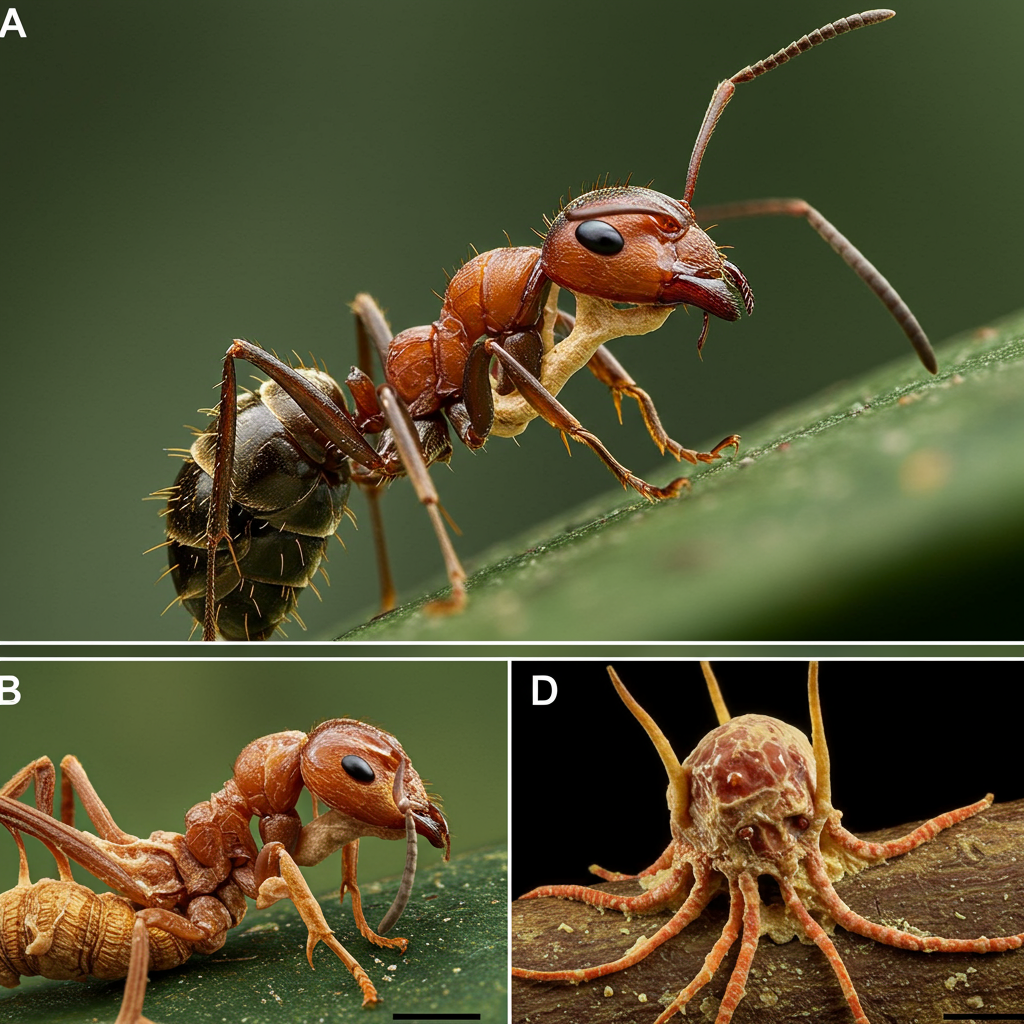For fans of the chilling post-apocalyptic world of The Last of Us, the concept of a fungus that turns living beings into mindless hosts is a terrifying reality. While the show’s premise features fungal infections taking over humans, the inspiration is rooted in a very real group of organisms known as “zombie fungi,” particularly the genus Ophiocordyceps. Now, groundbreaking discoveries are shedding light on the deep evolutionary history of these bizarre parasites, pushing their known origins back tens of millions of years.
Unearthing Cretaceous Parasites
Scientists have recently described two remarkable new species of ancient parasitic fungi, unearthed from precious amber dating back nearly 100 million years to the Mid-Cretaceous period. These fossilized fungi, named Paleoophiocordyceps gerontoformicae and P. ironomyiae, offer a rare glimpse into the prehistoric world of insect-infecting parasites.
Found preserved alongside their unfortunate hosts within the amber – P. gerontoformicae on a young ant and P. ironomyiae on a fly – these specimens represent some of the oldest physical evidence of complex fungal parasitism on insects. The rarity of such delicate fungal structures surviving as fossils makes this discovery particularly significant for understanding the early evolution of these organisms.
Pushing Back the Fungal Timeline
The discovery of Paleoophiocordyceps in Cretaceous amber dramatically extends the known fossil record for this group. Previously, the oldest direct fossil evidence of Ophiocordyceps dated back to the Eocene epoch, around 50 million years ago (though evidence of their characteristic “death grip” on leaves has been found slightly older). These new findings suggest that fungi with traits similar to modern Ophiocordyceps were already thriving and infecting insects nearly 100 million years ago.
Based on this fossil evidence and other data, researchers estimate that the lineage leading to modern Ophiocordyceps and these ancient Paleoophiocordyceps species diverged over 130 million years ago, during the Early Cretaceous. This implies these fascinating fungi evolved alongside the rise and diversification of flowering plants and various insect groups, potentially even playing a role in regulating ancient insect populations, much as they do today.
Scientists propose that early ancestors might have first targeted abundant beetle populations before adapting to infect other diversifying insect groups like ants and flies, demonstrating an ability for host-switching early in their evolutionary journey.
The Reality of Zombie Fungi
The genus Ophiocordyceps is perhaps the most famous example of entomopathogenic fungi – fungi that parasitize insects. While the fictional portrayal in The Last of Us depicts a global human pandemic, real Ophiocordyceps species are highly specialized, infecting specific insect hosts. The best-known example is the “zombie-ant fungus,” Ophiocordyceps unilateralis.
Once infected by a spore, the fungus invades the ant’s body, hijacking its central nervous system and manipulating its behavior. The fungus compels the ant to leave its colony and climb a nearby plant stem or leaf, typically seeking a location with specific temperature and humidity conditions ideal for fungal growth. At this chosen spot, often referred to as the “death grip,” the fungus immobilizes the ant, and it dies. The fungus then consumes the ant’s internal tissues and grows a stalk (stroma) that erupts from the ant’s head. Spores are released from this elevated position, raining down to potentially infect more ants below, ensuring the spread of the fungus within the ecosystem.
This bizarre form of behavioral manipulation isn’t unique to Ophiocordyceps. Other fungal species, like the recently described Gibellula attenboroughii, also exhibit “zombie-making” behavior, infecting cave-dwelling spiders and forcing them to move to high, dry locations on cave walls for optimal spore dispersal. These strategies highlight the diverse and often strange adaptations found within the fungal kingdom.
Are Humans Really at Risk?
Given the striking depiction in popular culture, it’s natural to wonder if these zombie fungi pose a threat to humans. The reassuring answer from scientists is no. The specific mechanisms that allow Ophiocordyceps and similar fungi to infect and manipulate insects are highly specialized and are ineffective against human biology.
Humans have a significantly higher body temperature than insects, which most insect-pathogenic fungi cannot tolerate. Our complex immune systems and different biological makeup also provide robust defenses. While it’s true that other types of fungi can infect humans (ranging from common issues like athlete’s foot and ringworm to serious, life-threatening infections, particularly for those with weakened immune systems), the specific “zombie” fungi targeting insects like ants and spiders do not pose a threat to human health.
Interestingly, some Cordyceps species have even been utilized in traditional medicine and explored for potential health benefits, including immune support and possible anti-cancer properties, underscoring the diverse nature of these organisms.
The discovery of these ancient Paleoophiocordyceps fossils reinforces that the strange and complex world of parasitic fungi has deep evolutionary roots, existing for millions of years, long before humans walked the Earth. While they continue to play a vital ecological role in regulating insect populations, their ancient secrets, now being unlocked from amber, offer a fascinating look into prehistoric life and the enduring power of natural selection.




